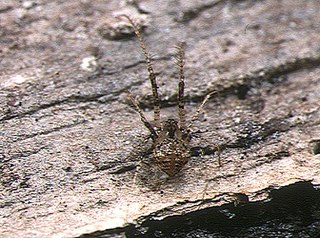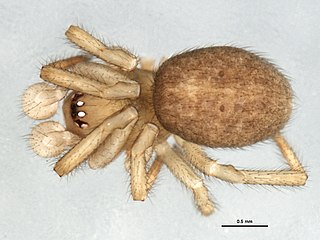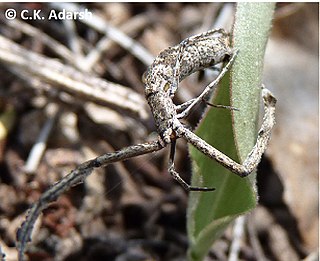
The spider genus Steatoda, in the family Theridiidae, includes about 120 recognized species, distributed around the world. One common name is cupboard spider, for many species build their webs in dark, sheltered, undisturbed places around the house or garden, in sheds and garages, under garden, compost bins, and the like. Signs of the cupboard spider include small white spots of spider droppings, like small splashes of paint, on the floor underneath the web.

Xysticus is a genus of ground crab spiders described by C. L. Koch in 1835, belonging to the order Araneae, family Thomisidae. The genus name is derived from the Ancient Greek root xyst, meaning "scraped, scraper".

Philoponella is a genus of uloborid spiders. Like all Uloboridae, these species have no venom.

Episinus is a genus of comb-footed spiders that was first described by Pierre André Latreille in 1809.

Castianeira is a genus of ant-like corinnid sac spiders first described by Eugen von Keyserling in 1879. They are found in Eurasia, Africa, and the Americas, but are absent from Australia. Twenty-six species are native to North America, and at least twice as many are native to Mexico and Central America.

Theridion is a genus of tangle-web spiders with a worldwide distribution. Notable species are the Hawaiian happy face spider (T. grallator), named for the iconic symbol on its abdomen, and T. nigroannulatum, one of few spider species that lives in social groups, attacking prey en masse to overwhelm them as a team.

Clubiona is a genus of sac spiders that was first described by Pierre André Latreille in 1804.

Mimetus is a genus of pirate spiders in the family Mimetidae. They are found worldwide.

Tibellus is a genus of slender crab spiders described by Simon in 1875, belonging to the order Araneae, family Philodromidae. Species of this genus are present in Eurasia, Africa, Americas and Australia.

Euryopis is a genus of comb-footed spiders that was first described by Anton Menge in 1868.

Robertus is a genus of comb-footed spiders that was first described by Octavius Pickard-Cambridge in 1879. It is considered a senior synonym of Garritus.

Miagrammopes is a genus of cribellate orb weavers first described by Octavius Pickard-Cambridge in 1870. These spiders have a unique shape and only four of their original eight eyes. They spin a single line of web, actively watching and jerking the line to catch their prey.

Micaria is a genus of ground spiders that was first described by Niklas Westring in 1851. They are 1.3 to 6.5 millimetres long.

Thymoites is a genus of comb-footed spiders that was first described by Eugen von Keyserling in 1884.

Phrurolithus is a genus of araneomorph spiders first described by C. L. Koch in 1839. First placed with the Liocranidae, it was moved to the Corinnidae in 2002, then to the Phrurolithidae in 2014.
















